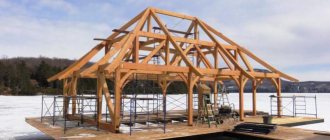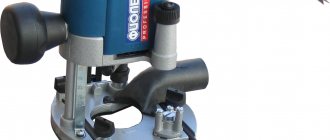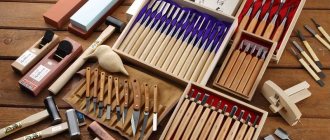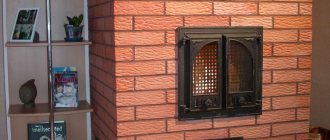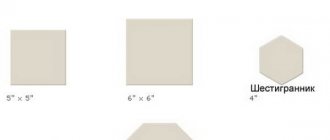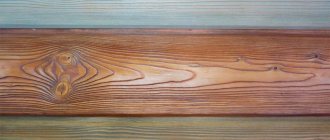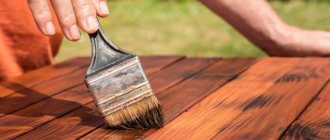Wood can be called the most beautiful building material that nature has created. However, wood is not only beautiful, but also capricious. Artificial materials have a uniform structure, but wood has a heterogeneous structure. When working with timber, you need to get used to its heterogeneity and learn to work with it.
Since timber consists of many fibers that are arranged vertically, and a much smaller number of horizontal fibers, the craftsman must learn to think through sawing wood in order to carry out a quality cut. In this article we will talk about longitudinal cutting.
Application
Using the chain carriage included in the mini sawmill, you can cut all types of wood - from hard oak to knotty pine.
The accuracy of setting the sawing parameters is set by the operator, and almost all models of chain saws provide a smooth surface that is easy to process in the future. The removal of sawdust, which is formed during the sawing process of wood, is carried out by a saw chain, and at the end of the process, the boards can be finally cleared of waste. The carriage is adjusted to a distance of 2 meters between logs (for longer logs) or 1 meter for shorter pieces of wood, which is suitable for cutting fruit trees. The mini chain sawmill with carriages model F2 is made of durable aluminum alloy, which has a protective coating. The maximum weight of timber that can be processed using these carriages is 1000 kg, with the longest processed log being 3800 mm. If it is necessary to work with long logs, the frame can be extended with fragments of the same type, which are available upon additional order. Also, several log lifts can be installed on or next to the frame, which allows you to process long logs with high productivity, while maintaining all the accuracy parameters.
You might prefer working with a rod stop
Instead of fiddling with adjusting the rip fence to compensate for drift, some craftsmen prefer to manually guide the boards using a rip fence (top photo). This method saves time by avoiding long setup times, especially when you only need to make one or two cuts. In this case, the surfaces of the boards usually turn out to be rougher, which will require additional work to level them on planing and thicknessing machines.
Some rip fences come with a removable rod attached to the side (bottom photo) or a semicircular trim, but they are not difficult to make yourself. To use the rod stop, install it at a distance from the saw blade equal to the thickness of the future plates and adding another 1.2 mm.
Place a longitudinal line on the workpiece. Pressing the workpiece against the fence, feed it forward, making sure that the cut follows the cutting line, and manually correct the deviations.
Longitudinal sawing of logs
Before cutting the logs, the optimal method is chosen, which depends on the size of the required lumber, the desired surface quality of the boards, the type of wood and technical capabilities.
They start cutting only after inspecting the log, after which it is freed from bark and branches. If there are no flaws on the log, then processing is faster, and the lumber is of higher quality.
Cut the logs
Depending on the orientation of the growth rings, different types of log cutting are used:
- Radial view - the cut passes along the radius of the growth rings. They obtain high quality lumber that does not deform.
- Tangential view - the log is sawn tangentially to the growth rings. The lumber is of low strength.
- Parallel view - the cut runs parallel to the grain of the wood.
For sawing in the direction of the grain, the simplest method is a circular cut. First of all, the croaker is cut off. After this, the log is turned 180 degrees, and then the second slab is cut off. To obtain boards, the log is constantly turned.
For high-quality sawing of logs in different ways, the following general rules are used:
so that the log does not move during processing, it is securely fixed; if sawing is done with a chainsaw, then use a chain for longitudinal processing
In order for the cut to be smooth and the saw not to be pulled to the side, the chain must be well sharpened and not sag; for sawing by hand, they try to select logs of short length; before sawing, the log is marked for a certain type of cut; sawing logs into boards begins with cutting the slab; special attention is paid to safety measures at all stages of sawing logs. Sawing logs on their own is carried out using various cutting tools. Sawing logs on your own is done using various cutting tools.
Sawing logs is done on your own using various cutting tools.
Electric or gasoline saws
A gasoline saw has advantages over an electric model:
- the workplace is not connected to a power source;
- higher power;
- thanks to soft start and speed control, the risk of saw chain breakage is reduced;
- continuous operation for up to an hour, there is no need to interrupt the cut to allow the saw to cool down;
- You can work in any humidity, for example during rain.
Mini disc sawmill
One or two disks separated by an insert are used as a cutting element.
This sawing machine is widely used because of its advantages:
- simple design, equipped with an electric or gasoline engine;
- easy to use;
- accuracy of cutting logs according to marks;
- high productivity when sawing logs.
The main requirement for a circular saw is a durable frame and a powerful engine.
The peculiarity of independent longitudinal cutting of a log is clearly visible in four simple methods.
How to protect yourself when working with a circular saw
Saw blades for wood, if handled incorrectly, can deprive a person of extra fingers or even limbs. Most often, the reason for this lies in violations of the basic rules of working with the device.
The operating instructions include several simple rules:
- It is prohibited to feed short workpieces manually. For this it is better to use special stops;
- It is not advisable to use a saw blade with a grinder. This is the most dangerous option. Even if you hold the tool very firmly, then when a tooth hits a nail or twig, it can jerk so strongly in your hands that you won’t be able to hold it;
It is prohibited to place such a saw blade on an angle grinder.
- some also remove the protective casing, installing a larger disk than the manufacturer intended. This is the sure way to the hospital;
- The dimensions of saw blades for wood must correspond to the mounting diameter. If you install a model with a large mounting hole without a special adapter, then eccentricity during rotation can lead to rupture and scattering of the disk. If such a fragment enters the body, the consequences are comparable to a shell fragment.
Types of log cutting
Before you start cutting the workpiece, you need to decide how to get a high-quality final product with the least amount of waste. The wood is uneven in quality; the lower part of the trunk produces the most valuable lumber. When sawing logs, you can obtain the following types of lumber:
- timber - lumber, more than 10 cm thick and wide. The most common type is four-edged timber, square in cross-section. Used as a building material and in furniture production;
- board - lumber, up to 10 cm thick and twice as wide as the thickness. Boards are obtained from logs or beams and are used in construction and in the furniture industry.
Having theoretical knowledge and practical skills, you can make boards and beams with your own hands.
Now everything is ready for dissolution
Using a planer and thicknesser, make the sides of the boards parallel and one edge straight and perpendicular. Estimate how many lamella plates you can get from one board, taking into account the width of the cut (1.5-2 mm) and the allowance for removing saw marks (1.5-3 mm). For example, from a 19 mm thick board you can only make two 6 mm plates.
Once you start sawing, press the board firmly against the fence and machine table, trying to maintain a uniform feed rate. Slow down the feed if the board gets stuck or the saw blade starts to move out of the way. If you are going to cut a board into three or more slices, plan the remainder of the board after each pass.
Then each sawn plate will have a flat base surface, necessary for final thickness calibration in a thickness planer. Finally, remove all sawing marks using a thicknesser or drum sander and give all the plates the same thickness.
Yield percentage
The average volume of output that should be obtained can be calculated in the following ways:
- According to the diameter of the trunk. Suitable in cases where all the sawlogs are the same size. To make the calculation, calculate the volume of one trunk and multiply it by the entire cubic capacity. The method has a slight error. The downside is that it takes a lot of time and human resources to accept products.
- By volume of transport. With this method, the volume of finished lumber for each type of transport is calculated separately. The method is used for large volumes of lumber, as it significantly speeds up calculations. Has a large percentage of error.
- Using measuring frames. This method has a high level of accuracy. When measuring, the curvature and thickening of the trunk are taken into account, which is impossible when calculating manually. The method also allows for immediate sorting of lumber, taking into account its further consumption.
- By multiplying the stack volume by a certain factor. The calculation has a high level of error. The method is used when measurements need to be carried out urgently.
Correct calculation of output affects the cost of future products. This indicator largely depends on the type of wood and how the wood was cut.
Overview of some options
We will tell you about the two most popular designs that provide the best quality when working, and you yourself will determine which is more convenient and preferable in your case.
Homemade option
First, let's look at how to make a device for sawing logs with a chainsaw with your own hands.
The instructions for carrying out the work are as follows:
- It is best to use a frame from an old school desk or a square pipe with a side of 20x20 or slightly larger.
- First of all, two clamps are made, these are elements 50-60 cm long, at one end of which a crossbar with two holes for tightening bolts and a small protrusion in the middle for clamping the tire is welded, an element of the same configuration is attached on top, the photo below shows ready-made elements, as you can see, everything is quite simple, and if you have a welding machine on hand, you can make them very quickly.
The clamps should be sized so that the width of the bolts is slightly greater than the height of the bar
- To longitudinally saw a log with a chainsaw, you need a support frame, the width of which should be 7-8 centimeters less than the length, two elements 10 cm long are welded perpendicular to two of the sides, they should be a little larger so that the clamps fit into them, you need install two fixing bolts; for this, a hole is drilled and nuts are welded in order to screw the fasteners into them; a handle is welded in the middle for ease of movement.
- The system is assembled in the following way: first, the clamps are inserted into the grooves, after which the chainsaw bar is inserted and carefully fixed. The distance is selected depending on the thickness at which sawing needs to be done. To understand how this is done, look at the photo, which shows the assembled structure, the price of the issue is several metal elements and rental of welding for an hour.
This is what the device looks like after assembly
Now we’ll tell you how to cut a log into boards with a chainsaw using this design:
- You will need two sawhorses to serve as supports, they should be of such a height as to ensure ease of work.
- A reliable metal strip or durable board is best suited as a guide. You can make this element from a corner or other metal products.
- A log is placed below, which needs to be set to the desired height, after which work can begin. After the first pass, the log is raised to the desired height and the process is repeated.
The work is quite simple, the main thing is to set everything accurately and fix it securely
Ready solution
The Big Mill Timberjig option is very popular; it is a special kit for equipping a mini sawmill. Sawing logs into boards with a chainsaw using this device is simple and effective.
By purchasing this option, you get everything you need; we’ll tell you how to organize the cutting of logs:
The design is very well thought out and is simple and reliable.
- First you need to connect two strong and even boards together, as a result you should get a T-shaped structure. This will be a stubborn ruler.
- Next, make two L-shaped stops; the delivery set includes corners that are designed specifically for these purposes.
- Roll up the log and place it on comfortable and reliable bars. Attach supports to its ends with self-tapping screws; you should not use nails, since they are much more difficult to remove later.
- Next, a ruler is attached to the installed wooden supports; this is done using clamps, which are also included in the kit, remember that the cut line does not go along the edge of the guide, but 10 millimeters higher.
- Before cutting a log into boards with a chainsaw, we recommend raising one side by about 30 degrees, this will make it much more convenient to work. Fix this position with the help of two supports; if something is not clear to you in the description, look at the photo, everything is shown clearly on it, in addition, the kit always comes with instructions with detailed diagrams.
How to cut a log into planks with a chainsaw? This device allows you to do this easily and quickly
Setting the stop
To accurately guide the board when sawing, we prefer to use a rip fence, which allows us to saw thin sheets of the same thickness over and over again. If your machine was not equipped with such a stop, you can purchase it separately, make it yourself according to the drawings, or simply attach a straight board with a height of at least 75 mm to the saw table with clamps.
By setting the stop parallel to the saw blade and perpendicular to the edge of the saw table, make sure that there is no so-called drift, when the cut deviates to one side or the other from the intended direction. To do this, run a straight line in the middle of the cutting board parallel to the left edge. Pressing the left edge against the longitudinal stop, cut the trim lengthwise , starting to cut along the mowing line.
If the saw blade tends to drift, the fence will need to be adjusted to compensate for the drift, as shown in the pictures below, to achieve clean cuts. Once you adjust the rip fence to compensate for drift, you won't have to do it again until the next saw blade change.
Chainsaw sawmill
This type of design is the easiest to manufacture, but it will also require special skills, tools and experience working with them.
This type involves installing the carriage on guides, but is not mandatory. You can use a flat wooden plank as guides, along which the carriage structure will slide easily. It allows you to remove the first layer evenly. The cutting plane on the log is used as subsequent guides.
Attention! The absence of a frame and carriage adds a number of difficulties. The craftsman may have problems holding the log in one position. It is impossible to start work without proper fixation, as this can lead to injury.
You cannot start work without proper fixation, as this can lead to injury.
The step-by-step process for making a carriage for a chainsaw will look like this:
- Let's make the base. To do this, we weld together a pipe measuring 25x25 mm.
- Perpendicular tubes, the size of which is 30x30 mm, are welded to the base on opposite sides. They are necessary for attaching the moving part that holds the saw and sets the thickness of the planks to be cut.
- Nuts are welded into the side parts of the guides. With their help, it will be possible to fix the moving parts at the desired height with bolts.
- We make the moving part. It consists of two pipes with a T-shaped end. The end of the pipes is made in the form of a vice, clamped with bolts and nuts. These clamps will hold the chainsaw blade. Pipe size – 25x25 mm.
- To prevent the saw chain from rubbing against metal parts, two metal plates of the required sizes are welded onto the internal parts of the vice. They completely depend on the thickness and width of the chainsaw blade.
- We assemble the carriage into a single structure, select the desired height and install the saw. The sawmill is ready for use.
The video below fully describes the carriage manufacturing process. In addition, the author of this device notes the main difficulties and some inaccuracies that he made during the assembly of the sawmill. This will allow you to avoid such mistakes and make the device for sawing logs more practical.
Bottom line! This carriage design is suitable for personal use and one-time sawing of wood. It is not suitable for commercial purposes.
Safety rules to follow
It is better not to approach the process of sawing firewood without preparation. Before work, I studied a number of safety requirements, which I am happy to share with you:
- First of all, I made sure that the gasoline saw was ready for use and assessed whether the attachment was installed correctly. To determine the presence of an error, you can initially make a drawing, which can then be used to construct a guide.
- I prepared the place and checked the reliability of fastening of all the parts, because if something gets unscrewed during the cutting process, it will not only have an incorrect effect on the lumber, but can also be dangerous to health.
- He put on overalls and a protective transparent mask. At this stage, I also advise you to use assembly gloves to protect your hands from splinters and accidental cuts from wood knots.
- I prepared a first aid kit in case I needed to give myself first aid. I put peroxide, a bandage, a cotton swab, and brilliant green into it.
Source arbeiterkammer.at
I recommend not to neglect any of the listed rules, because the result of preparing lumber depends on their compliance.
Using a chainsaw for longitudinal cutting
Let's consider the technology for manufacturing these lumber using a carriage:
The carriage is made by sequentially cutting off opposite sides. First, cut off the top of the slab until a flat, even surface is obtained. Then the log is turned over, laid on a flat cut surface, and the operation is repeated on the opposite side.
The beam is made by sequentially removing the slab. First they make a carriage, then remove the slab from the sides in a similar way
It is important to ensure that the sides are perpendicular to each other. An unedged board is made from an unsanded log (with the bark not removed)
The most convenient way is to remove the slab, lay the log on the resulting flat surface and sequentially cut the boards to the required thickness
An unedged board is made from an unsanded log (with the bark not removed). The most convenient way is to remove the slab, lay the log on the resulting flat surface and sequentially cut the boards to the required thickness
After each pass, the saw is lowered by the thickness of the board plus the thickness of the chain cut.
To make an edged board, first make a carriage, then cut off a slab from one of the sides and lay the resulting three-edged beam on the middle face. After this, the boards are cut sequentially, the side surfaces of which will be parallel, and the width of all boards will be the same.
Figure 5 - Types of lumber
If you have certain experience and skills, you can cut grooves, quarters and other longitudinal relief shapes. To do this, you need to position the workpiece taking into account the reach of the saw frame and the depth of the chain insertion into the material. Such work is quite complex and requires precision and sufficient width of the support area.
Five Reasons to Dissolve
Release the board. means cutting it along its thickness, cutting along the edge. Mastering this technique opens up many new opportunities for you.
Effective use of boards made from rare or expensive exotic species. You can make more parts for your project from one piece of valuable wood. For example, when making doors from bubingo, birdseye maple, or Karelian birch, instead of making panels entirely from boards, simply saw one board into several thin sheets and glue them onto an inexpensive plywood or MDF backing. The edges of the panels will be hidden in the frame, and nothing will spoil the impression of your work.
READ How to properly cut a ceiling plinth
Less material loss during thicknessing. Let's say your project requires parts that are 6mm thick. Blanks for them cannot be found on sale, and you only have 20 mm boards. Instead of turning more than 2/3 of the material into chips using a planer, simply cut the boards in two and then finish them to 6mm thickness.
Planing knives will last longer. Replacing and sharpening dull or serrated planer knives takes much longer than replacing a worn band saw blade, so it makes sense to reduce wear on expensive knives if possible. Flatten thick workpieces into plates slightly thicker than required, and then calibrate them in one or two passes to the final size on a planer.
Obtaining blanks with a symmetrical pattern. Many panel projects, from cabinet doors to box lids, can be achieved by simply unraveling the board and arranging the two panels to create a symmetrical book-like design (left photo above). In this way, you can cut boards and glue the resulting blanks into panels, which will look great as the side wall of a body or lid.
Curvilinear parts are easier to glue than to bend. Without resorting to steam bending, you can glue them together from several thin strips (usually about 3 mm thick). Such gluing, as a rule, bends less. Cut the board into strips, sharpen or sand them, and then glue them together by pressing them against the template. How this is done is described in the article “Chair with a footrest.”
Some useful tips
A sawmill is an impressively sized unit that is quite dangerous to operate, so before you start assembling it, you should carefully consider the place where it will be used. It should be well lit, ventilated and have free space. The nearby warehouse for finished boards will greatly facilitate the process of processing the material. For a sawmill with an electric motor, you should very carefully install the necessary switches and automatic machines, as well as install the wiring.
Since the most dangerous elements of the unit are all its cutting and moving parts, when assembling the structure they should be given special attention. Before using the assembled equipment, it is necessary to check all fastenings and components, as well as the stability of the structure.
Before starting to operate the assembled equipment, it is necessary to check all fastenings and components, as well as the stability of the structure.
Types of groove boards
Symmetrical groove
Many users have no idea how to choose a groove in a board, believing that the store will offer them only one connection and material option.
This is far from true; there you will be greeted by a large assortment:
1. Symmetrical groove. This is the simplest type. In it, the lengths of the upper and lower shelves are the same, and they protrude at the same distance.
Asymmetric connection
2. Asymmetrical groove. Here the upper shelves are longer than the lower ones.
3. Block house, used mainly for finishing walls and ceilings. The planks often imitate the relief of timber and have a semicircular or shaped profile on the front side.
4. Euro lining, just like block house, is often equipped with a relief pattern.
5. The decking board, made of wood and polymer, also has tongues and grooves for easy installation.
Note! If you plan to mount walls that are not level, have protrusions and dents without a groove board, do not expect good quality from the result. The cladding will not lie flat, height differences and cracks are inevitable.
The procedure for performing preparatory work
To cut a log lengthwise, you need to perform the following sequence of actions:
- Take two straight boards and attach one to the other at right angles. The result is a strong guide line.
- To support the manufactured ruler, you need to make stops from boards.
- Moving the trunks must be done using a tilter.
- The log should be placed on a comfortable base.
- You need to secure the frame to the chainsaw bar using nuts.
- The supports of the leading ruler must be attached to the ends of the log, checking the horizontal position with a level.
- Self-tapping screws must be used to secure all brackets and structural elements. Nails are not suitable for these purposes, since they are difficult to remove in the future without causing damage to the structural parts.
- The leading ruler needs to be attached to the supports using brackets and its height adjusted taking into account that the cut will not go along it, but approximately one centimeter higher.
- The log needs to be rotated and the second board secured so that it rests on the ground and supports the log.
Work order
Before starting sawing, it is necessary to free the prepared logs from bark and remaining branches and carefully inspect them for any possible defects. This will allow you to choose the optimal cutting pattern and thereby reduce the amount of possible waste.
When sawing logs longitudinally, care must be taken to ensure that the resulting boards have the same density across the entire width. Since the density of the trunk wood on the north side is much greater than on the south side, the cut is made in a plane directed from east to west (or vice versa).
The first operation when longitudinally sawing a log with a chainsaw is to remove the slab from two opposite sides of the trunk. As a result, a double-edged beam is formed, which is then sawn into boards of equal thickness or other lumber, in accordance with the selected sawing pattern. The output is an unedged board, from which the edges are subsequently removed.
If there is a false core or other defects in the log, it can be rotated 90° or 180°, as with the circular sawing method.
Sawing logs at home
Situations often arise when it is necessary to produce a relatively small number of boards or beams for personal needs. In this case, the purchase of sawmills and other equipment is impractical. If you have certain knowledge and skills, it is much more profitable to cut logs manually, using an electric or gasoline chain saw. This is a rather labor-intensive process, but in some cases it is completely justified.
Most experts agree that using a chainsaw is preferable. Such saws, unlike electric ones, have more power and are able to work without interruption for a long time. In addition, when using a chainsaw, no electricity is required, which allows you to carry out work remotely from power sources (for example, directly on plots).
When cutting logs into boards using a chainsaw, you will need special devices: a device for securing the log, a frame attachment for the chainsaw and a guide along which the cut will be made. The attachment frame is attached to the chainsaw bar so that the distance between it and the chain can be adjusted. This will allow you to get boards of varying thicknesses. It is better to choose a special chain for longitudinal cutting, which differs in the angle of sharpening of the teeth. Sawing logs into boards with a chainsaw with how to cut logs into boards. A metal profile of the required length or a flat, rigid board is quite suitable as a guide.
Maintaining safety during work
To avoid malfunctions and accidents, you should follow safety precautions when working with materials and tools:
- When working, do not allow third parties, especially children, onto the work site.
- During work, you should use protective equipment against noise and sawdust that fly away during cutting.
- It is necessary to have a first aid kit with everything you need to use in case of cuts.
- When using a circular saw, it is necessary to put on a protective guard.
- Do not pour gasoline into a heated chainsaw tank.
- Use the chainsaw only for its intended purpose, do not turn it on at full power if it is not in operation.
- There is no need to put too much pressure on the saw while working.
- The log for cutting should be installed on the right side.
A chainsaw serves as a convenient tool that can be used to make boards yourself. On
How to do something yourself, with your own hands - home craftsman website
And a little magic
When all verification operations are completed, it is time to begin the project itself. While rummaging through my lumber stash, I found a piece of wood with a fascinating grain pattern that I thought would look amazing as 6mm wide panels on the doors of a jewelry storage cabinet.
I set the guide 8mm from the saw blade (6mm plus 1.5mm for the next sanding) and started loosening. I chose the feeding speed taking into account the density of the workpiece (it was amber wood) and its width (approximately 18 cm). Checking the first sawn piece showed that the saw settings were correct - and I sawed off the second piece. The resulting pair of front panels (photo below) is a good example of how beautiful boards sawn in this manner can be.
After gluing the veneer to the substrate, the front side must be sanded. Multilayer plywood or MDF sheet are perfectly suitable for the substrate, since they are virtually not subject to expansion and contraction when humidity changes.
These freshly sawn pieces still needed to adjust to the humidity level in the workshop, so I stacked them with slats for a day or two to keep them from warping (photo above left). After which I glued them together and planed them to a final thickness of 6 mm.
If I needed to obtain veneer from a blank, my actions would differ in the most insignificant way. I would adjust the guide to cut sheets 3 mm wide, and before each new cut I would plan or sand the workpiece. This technique allows you to get one smooth and even side on each veneer sheet, suitable for gluing. You see, have you ever thought that a band saw is only suitable for cutting curved lines!
TOOLS FOR HOME AND GARDEN, HANDCRAFTS, ETC. PRICES VERY LOW
Take a canvas with a more brutal cut. A blade with 3 teeth per inch and larger grooves between them better removes sawdust, which can cause the cutting blade to bend and twist. Keep the workpiece firmly pressed against the guide and the table. A special pusher transmits the required pressing force to the guide and allows your hands to be at a safe distance from the canvas when it is unraveled.
Once the band saw is perfectly tuned, you need to pay extra attention to the saw blade. Sawing wide boards requires a blade that moderately passes through the entire thickness of the workpiece, while removing a huge amount of sawdust. The wider the blade, the straighter the cut, so try to use the widest blade that will fit your saw.
Place the square 6mm from the saw blade (you may need to lift the guard to position it) and press down on the middle of the blade with your finger. Using medium pressure, the blade should touch the square. In this photo, the saw blade is very much shifted backwards on the upper drive wheel: therefore, the cut deviates towards the guide. If the blade is very much shifted towards the front edge of the wheel, this leads to the opposite result.
Most band saws work very little with 12mm blades, and many with even wider ones. Typically, a wide blade with 3 teeth per inch of length (3 tpi) offers the perfect combination of brutal yet smooth cuts with active sawdust removal, which is what you want when dissolving wood. Finally, let's talk about guides. The workpiece to be cut should be less than twice the height of the guide. So, for example, a 100 mm guide is suitable for cutting a board 200 mm wide. If you require greater height, use homemade additional guides.
Features of a homemade sawing option
It is easy to saw a log into boards using a homemade tool. Manufacturing the equipment is simple:
Diagram of a homemade sawing machine
As a support, you need to use a frame from a school desk or a pipe with a cross-section in the form of a square, its optimal size is 20x20, more is allowed. Build two clamps, mount a cross member with two holes for tie bolts at one end, and make a protrusion in the middle for the tire. For longitudinal sawing of logs into boards, it is important to make a support frame; its width must be 7–8 cm less than the length. Then two elements 10 cm long are welded to both sides, holes are made for the bolts, and a handle is attached in the middle for ease of operation. After this, insert the clamps into the grooves, the tire is installed, and everything is carefully fixed.
Working with a homemade tool is not difficult; for this you will need two sawhorses, they will serve as a support, and you also need to prepare a metal strip or board, the element will be a guiding element. A log is placed underneath and the required height for work is adjusted.
Technique for sawing logs lengthwise
The difficult part in this process is making the first cut; for this you need:
Drawing of a board cut lengthwise
- Mount the leading ruler; it consists of two boards fastened together at an angle of 90 degrees.
- Place the log on the supports and secure its position firmly.
- Check if the log is level using a level.
- Using self-tapping screws, secure the guide ruler to the supports.
- Fix another guide in a horizontal position; the element will rest against the ground, but at the same time fix the log.
- Saw the log.
During the second cut, specialists may not use a leading ruler; the resulting board will serve as a guide. The second cut is made perpendicular to the first.
Secrets of cross cutting
A crosscut saw is used to produce firewood or decorative interior elements. Sawing is carried out according to the following principles:
Types of cuts
- Place the log in a horizontal position on wooden supports, the height should be 0.5 m.
- Clean it from the bark.
- Using an ax or saw, make small marks along the entire length; they should be located at the same distance from each other.
- Make a cut along the cuts.
Cross cutting does not require the use of special devices or attachments. An ordinary chain is perfect for such work, but its rings must be strong.
DISSOLVING A TREE: TO THE START, ATTENTION, MARCH!
Start by assigning a rectangular shape to your workpiece and cutting wood of a similar size. With it, you can check how flat it lies on the saw table and how tightly it fits into the guide, and also adjust the band saw options. Secure the guide according to the desired cutting thickness and slowly feed the workpiece under the saw blade. At the same time, the saw motor should rotate moderately, without jamming. At the end of the cut, advance the workpiece using a pusher. Then inspect the sawn piece.
Move the guide to the angle required to align the cut. The guide adjusting bolt simplifies this problem. You can also use magnetic guides (for example, Carter Magnafence: carterproducts.com) - they significantly simplify such temporary adjustment.
If it turns out to be thicker at the top or bottom, check that the saw table is set exactly at 90° to the saw blade and adjust it as necessary.
If there is a depression or unevenness in the material, the problem may consist of insufficient saw blade tension. On many saws, the integrated tension controls are not very accurate.
Here is a perfect example of a symmetrical grain pattern. Such panels will make any furniture look even more attractive than two ordinary thick panels made from different boards.
A properly tensioned blade or blade should deviate less than 6 mm when pressed in the center (photo above left).
A very high speed of feeding material under the blade, the use of narrow blades with very frequent teeth or dull blades can also cause similar curvatures when cutting. If one end of the sawn part turns out to be thicker than the other, the problem lies in the displacement of the blade, in other words, the blade deviates from parallel relative to the guide.
If the blade is sharp, the guides are installed correctly, the feed speed is selected correctly, but the problem is still not resolved, try adjusting the tilt of the upper drive wheel so that the saw blade passes exactly in the center of both wheels (photo above right).
If this does not bring the expected result, adjust the position of the guide to compensate for the deviation of the blade. Oh, that's how it's done. Saw a block of wood into a rectangle, similar in thickness and density to the wood that you plan to saw, and draw a line on it with a pencil, parallel to the edge.
To prevent the workpieces from moving (to restore the moisture balance), it is best to lay them with slats. In this case, scraps of plywood were used as slats. They need to be positioned symmetrically, and pressed down with a weight on top to prevent the panels from bending during drying.
Without securing the fence in place, saw the block along the marked mowing line, holding it with your hands. Just before you reach the end of the cut, turn off the saw and, without moving the workpiece, run a pencil along the edge of the cut on the saw table. Set the stop exactly parallel to this mowing line (photo on the left) - as a rule, this allows you to perfectly compensate for the mixing.
In general, every time I change the saw blade, I check everything again and, if necessary, adjust the saw settings again.
READ DIY Reciprocating Saw Blade
Sawing map
The sawing map is a calculation of the optimal amount of finished lumber from one log. You can calculate it yourself for each specific log diameter, or you can use a computer program that greatly facilitates the calculation, and the price of which is quite affordable.
Material yield after cutting wood
Or the source could be a regular sawmill reference book. The result is a table that is used as a basis. The sawmill attachment should always be oriented to its data in order to obtain more lumber of any type of wood.

